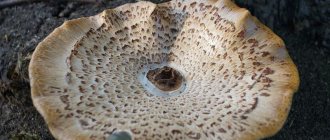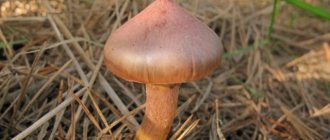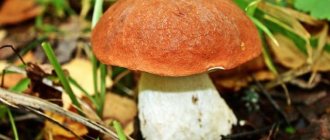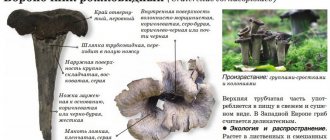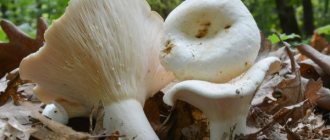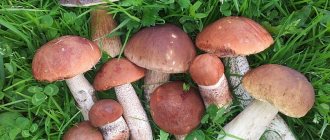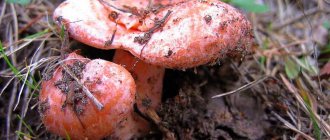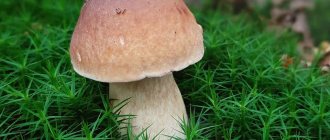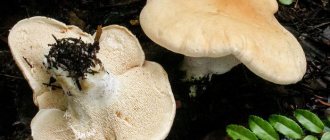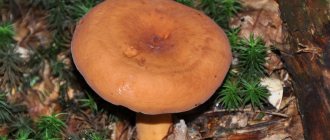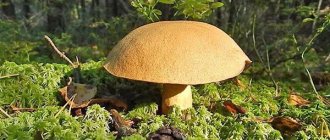Valui photo and description
Valueu has other names. It is called a fist, a snotty one, a crying one, a goby, a kulbik and so on. All these names were not invented without reason, but directly correspond to external characteristics. From Latin Rússula foétens. We'll tell you how to distinguish the plakun mushroom from other representatives of the order.
hat
The mushroom cap immediately catches your eye. It has a height of 6 cm. Its diameter is from 13 to 15 cm. Most often in Russian forests there is a light brown tint. The surface of the mushroom is very slippery and slimy. You can feel the compaction in the center. The cap is semicircular, but the older the mushroom, the flatter it becomes.
Records
The plates are located directly under the mushroom cap. They have a cream or light gray tint. A yellowish liquid is released between them. It is this that gradually dries out, leaving dark spots. When cut, the flesh is white, but when exposed to oxygen it begins to darken. It is odorless and has a rather pungent taste. The structure of the plates is very brittle.
Leg
The height of the stem varies from 5 to 15 cm. Its diameter is 4 cm. The cap clasps the stem very tightly, thanks to which the mushroom withstands the influence of external factors. The leg is cylindrical. Dense. Has a light shade.
The older the mushroom, the looser and softer its stem. When tilted, you can see its dark color inside.
Pulp
The young mushroom has white, quite dense flesh. If you pick at it with a knife, it comes off in plates and separate pieces. When interacting with oxygen it begins to darken.
If the flu is old, then the pulp is quite loose, the knife will sink into it. The mushroom is not so stuffed, flattened. The pulp darkens even without interaction with oxygen. In the section you can see a grayish or yellow tint.
What does Gebeloma adhesive look like?
The diameter of the cap of Hebeloma adhesive can be from 3 to 10 cm. Its color is yellowish-brown, with a noticeable darkening in the center. In young fruiting bodies it has a convex cushion-like shape. With age, its surface flattens, and a wide tubercle appears on it.
At an early age, the cap is covered with mucus; over time, it becomes dry and shiny. Depending on external factors, the color can vary from grayish to red-brown. The edges of the cap are slightly bent.
Hebeloma adhesive specimens of different ages
The leg has a cylindrical shape. Its diameter is 1-2 cm, and its length is from 3 to 10 cm. At first it is white, but with age it becomes yellowish, then brown. In addition, in mature specimens the leg becomes noticeably thicker from below. It is hollow inside and has a scaly outer covering.
The hymenophore is lamellar, its color is the same as that of the leg: at first whitish, over time it becomes yellow or brown. The plates have small grooves on which drops of liquid form in wet weather. It has a brown color due to the presence of spores.
The drying liquid causes the hymenophore to darken
The pulp is white; in older specimens of Hebeloma adhesive it is yellowish. Its layer is thick and the consistency is loose. The taste of the pulp is bitter, the smell is pungent, reminiscent of radish.
Edibility of Goby
Valuy mushroom is classified as edible or conditionally edible mushroom.
It can be eaten only after appropriate processing. It can be soaked for several days, boiled for 20-30 minutes, pickled or salted.
Foreign experts classify it as an inedible mushroom. But in Russia, from time immemorial, the plakun mushroom often found its way onto the dinner table.
In order not to harm your health, you need to collect only young bulls. It's easy to check their age. The cap should be semicircular and the flesh inside should be white.
In addition, this flu should not have a bad smell.
But you shouldn’t be afraid of a slippery hat.
Danger from the mushroom
When consuming fresh valuuy, a person experiences a serious digestive upset, which is accompanied by nausea and vomiting, painful cramps in the abdomen, so the product can only be eaten after careful cooking, and absolute contraindications to its use are:
- children under 12 years of age;
- pregnancy and lactation;
- liver and stomach diseases;
- kidney disease;
- individual intolerance to the product.
The pulp of the barn is capable of absorbing toxic substances, so mushrooms need to be collected in environmentally friendly areas located away from highways and industrial enterprises.
Did you know? One of the largest mushrooms was found in 1985 in Wisconsin (USA) - its weight was about 140 kg!
Valuy does not look very attractive and has a specific taste, but if prepared correctly it can become a savory ingredient for various dishes. Using the information presented in the article, you can easily distinguish goby from other types of mushrooms, use it in cooking, and even grow it yourself on your own plot.
Characteristics
Belongs to the genus: Russula.
Family: Russula.
Department: basidiomycetes.
Order: Russulaceae.
Kingdom: mushrooms.
It can grow in both coniferous and deciduous forests. It is most often found in North America, Eurasia, and has become most widespread in the European part of Russia, Western Siberia, the Caucasus and the Far East. Grows in shady and damp places in small groups. Prefers birch trees.
Did you know? A must read - Svinushka - was previously conditionally edible, but is now classified as poisonous.
Distribution and fruiting season
The habitat of false value is deciduous and coniferous forests. Valui can also be found on the edge of the forest, clearing, meadows and fields. Valuy grows singly or occurs in small colonies. He prefers the conditions of the northern temperate climate zone.
In Russia, valui can be found in the Far Eastern region. It also grows in the countries of Central Asia and the Caucasus.
The fruiting period begins in the summer months and continues until the end of November. In areas with milder winters, you can collect valui during the cold season.
It is important to distinguish between false and edible valui.
Nutritional value and calorie content
The calorie content of plakun is 29 kilocalories per 100 g of product.
Compound
The chemical composition of value is the envy of many fruits and vegetables. It contains the following vitamins:
- A;
- B1;
- B2;
- B5;
- B6;
- B9;
- D;
- RR.
In addition, it contains essential minerals for the human body. Among them are copper, calcium, iron, manganese, potassium, sodium, phosphorus, aluminum.
Agree, a mushroom with such a composition can claim to be useful. Moreover, with dosed consumption of value, it is impossible to harm the body. The main thing is proper processing and careful selection.
False Valuy
From a distance, valui looks very much like a porcini mushroom with a rounded brownish cap. And how often it is confused with some types of strong russula. But it is not the porcini mushroom or the russula that scare away mushroom pickers, but some types of inedible Hebeloma . This mushroom has a second name - “false valui”. The cap is also slimy and yellowish-brown in color. The bitter pulp smells like radish. Hebeloma is a common mushroom that grows in groups. If you look closely at it, it becomes clear that there may be similarities, but there are many more significant differences. For example, on the legs of many species you can see discreet horizontal bracelets of curls. The edges of the hebeloma cap are slightly wavy.
Beneficial features
Valui mushroom can be extremely beneficial. It allows you to provide a good supply of natural protein, because its amount in 250 g of mushroom exceeds the amount recorded in beef meat.
Considering that plakun contains many vitamins and minerals, if consumed regularly it will have a positive effect on human health.
The beneficial substances contained in the bull help reduce blood sugar and cholesterol levels, and have a positive effect on blood pressure and heart rate. Blood supply and metabolism processes improve.
Valuei mushrooms may have antioxidant, immunostimulating and anti-inflammatory effects. This has a positive effect on the treatment of infectious diseases.
Despite the fact that valui is considered a conditionally edible mushroom, with proper heat treatment it brings many benefits. However, in its raw form it has a burning and bitter taste, and when it enters the oral cavity, it has an unpleasant sensation. Eating bull in this form can cause enormous damage to health. At best, this will lead to poisoning with the most unpleasant consequences.
Signs of poisoning and first aid
The substances contained in the pulp of this mushroom are toxic to the human body, but they have not yet been identified and have been very poorly studied. But it is undeniable that their toxicity is very high.
The toxic substances contained in the pulp of this mushroom have a significant negative effect on the human digestive system. The first symptoms of poisoning appear very quickly, a short period of time after eating hebeloma:
- loose stools;
- nausea and vomiting;
- colic.
There are: breathing problems, headaches, thirst, and in severe cases – paralysis of the limbs. If a person feels at least one of the signs of mushroom poisoning, then they should immediately call an ambulance.
First aid to the victim is to cleanse the digestive tract of mushroom toxins that have not yet been absorbed into the blood. Usually, this is done by washing the stomach with boiled water or taking activated charcoal. And in any case, a team of doctors is called to the house.
Sticky hebeloma is a mushroom with which it is better not to joke. You can end up in the hospital with poisoning from this “gift” of the forest very quickly. Fortunately, it is very easy to distinguish hebeloma from other species due to its smell, so if the mushroom you cut has a strong and unpleasant aroma, then it is better to throw it aside and move on.
Where can you find value
Valuy lives in the forests. He does not like sunny open spaces blown by winds. He “prefers” calm, solitude and twilight. The mushroom adapts perfectly to coniferous and deciduous forests. Likes to hide under a carpet of grass or fallen leaves.
It accepts moderate moisture, so it is found in areas of the European part of Russia, the Far East and the Caucasus.
It grows in small groups, so if you find a couple of mushrooms, you can safely move a few meters away. You won't find any other representatives of this species nearby.
What it looks like, other names and habitat
Although the inhabitants of Europe did not like this mushroom, our residents loved it and created a lot of recipes with it. It also has a large number of “folk” names:
- Cowshed
- Svinur
- Kubar
- Kulbik
- Cam
- Goby
- Snotty
- Stinky Russula
- Kubyshka
- Boulder
- Fist
What does it look like
Valui mushrooms and everything you need to know
- The cams have a cap up to five centimeters thick. Hemispherical in young individuals and stretches into a saucer-like shape when aged. The light brown tint hardly changes with age. The age is clearly determined by the cap, so when searching, I advise you to collect young individuals with a hemispherical crown
- The leg is from five to fifteen centimeters high, the diameter of which rarely exceeds 4 centimeters
- Slippery cap even on young representatives of the species
- The lower part is characterized by a light yellow color and cream-colored plates
- The meat has a palette of colors from white to cream shades. Brittle structure and dense composition
Reasons for receiving names
- Snot - the cap secretes a lot of mucus, which led to its name. A particularly large amount of mucus is released after rain.
- Stinky Russula - a pronounced almond smell gives it this strange name
The reasons for the appearance of the remaining names are unknown to me. Also, I could not find them on the Internet.
Habitat, collection features
Shady lawns of deciduous and mixed forests are a favorite place for growth. Snotlings especially like to grow where there are a lot of large boulders, in the middle of birch groves. Cannot be found in coniferous forests.
They grow mainly in small colonies of up to five individuals and can be found in the following regions:
- Caucasus
- Far East
- Western Siberia
- Europe
- North America
At the beginning of July, the harvest period begins, mushroom rains begin - growth begins. You can find them in the forests until October. The end of growth occurs at the first autumn cold snap.
When collecting, you should always remember about the growth characteristics that I indicated above and the external differences from their poisonous counterparts:
- Similarities with Russula: they are like twins, the only difference is the edges of the caps
- It has a similar appearance and color to boletus. You can distinguish it by the cap with plates near the fist.
False values and doubles
Amanita straw yellow
A young straw-yellow fly agaric can also go behind the valua. This mushroom belongs to the Amonitaceae family and is easy to distinguish, but only upon closer examination. The fly agaric has a small white skirt on its leg, which the plakun does not have.
In addition, if the mushroom is not collected at the beginning of the season, but towards the end, then characteristic pigmented white spots begin to appear on the fly agaric cap, quite convex and noticeable to the human eye.
Gebeloma adhesive (false valui)
Gebeloma adhesive strongly resembles valui. But this is a false cry. Hebeloma has a sharp, unpleasant odor that can be felt even from afar. Many compare it to horseradish.
False tree grows from August to October. It is popularly called “horseradish mushroom”.
It is easy to distinguish a fake from a real value. To do this, it is enough to check three signs.
- A real rowing mushroom has a small tubercle-seal in the center of the cap, which can be easily felt.
- The leg thickens towards the base. It has small scales.
- The cap and leg are snow-white, when the double's is brown.
Russula almond (lat. Russula laurocerasi)
Mushroom pickers who have little experience may confuse valui with almond russula. This flu has a pleasant almond smell, its plates are yellow, and there is a slight purple tint on the cap.
But even if you collect almond russula, don’t worry, it’s edible.
Description of the edible mushroom Valuya
Valui mushroom in the photo
(Russula foetens) in the photo
The valui mushroom (Russula foetens) is often called the cam, snot mushroom, and foul-smelling russula. He has a strange fate. It is not considered a bad mushroom, much less a toadstool. Everyone knows that valui is an edible mushroom, and yet they almost never take it. And yet it grows in such abundance and is so conspicuous that it seems as if it was created on purpose so that there would be something to knock down in the forest. Not a single mushroom, including the fly agaric, suffers from kicks as much as the valuya. Perhaps it evokes such feelings on the part of mushroom pickers because from a distance it is often mistaken for some other mushroom. The description of the value mushroom is very reminiscent of the description of the boletus mushroom, and when they are convinced that it is not a porcini mushroom, people kick in their hearts.
As you know, in early youth, valui is a ball of different sizes, ranging from a simple hazelnut, passing through the walnut stage, to a medium apple. The ball is covered with abundant mucus.
When you cut it off, you will find that there is also a stem, but it is so tightly wrapped around the edges of the cap that it seems to have grown together with them. However, this stem can be plucked out with the tip of a knife, and then the ball becomes hollow and clean small plates can be seen there. And in the very depths there was a white, yellowish speck, where the torn out leg was attached to the cap.
These stems from ball mushrooms have to be picked out very often, because it happens that at a very young age the valui is already infected with a wormhole, which in young mushrooms rarely spreads beyond the stem. Thus, having picked out the wormy leg, you put a completely fresh cap into the basket - a round ball, now empty inside. However, you need to keep in mind that the stem of the valuu is hollow, and this cavity is darker than the rest of the meat of the mushroom, it is almost brown, and at first glance, the natural cavity in the stem can be mistaken for worms.
Approaching the size of a small or medium apple, the edges of the cap move away from the stem and begin to gradually straighten, although there are also quite large boulders that retain a strong, elastic ball shape. By this time, the mucus disappears and the mushroom becomes dry.
With further growth, the cap finally straightens and can become completely flat or even slightly concave. We are talking about values the size of a tea saucer. Naturally, such a hat becomes fragile, especially around the edges. Brown spots usually appear on the plates of large valuevs, which gives the unpleasant impression of a rotting mushroom. However, these spots are not rot at all, but simply a feature of the value, quite benign. But even knowing this, putting such a mushroom into the basket is less pleasant than a younger mushroom with clean, yellowish-white plates.
Neglect of value may arise from the following circumstance. The mushroom picker takes a basket and goes into the forest for white mushrooms, aspen trees, birch trees, chanterelles, and trumpet mushrooms. He will collect these mushrooms for half a day and bring home an almost full basket and will sort out which mushroom goes where, and all this is a great pleasure for the mushroom picker. But then, entering the forest, he attacks scatterings of value. You can cut a full basket in ten minutes, and then you have to go home. But what about white boletuses, boletuses and boletuses? Should they really be left in the forest? The mushroom picker has a choice: either leave the valui in the forest, or all the other mushrooms. The mushroom picker usually gives preference to everyone else.
You can adapt to this psychology and make special forays into the forest only for the trees. At this time, you don’t need to think about other mushrooms, you can pick them in the morning, and now there is only one task - to get to the forest and cut the magnificent valui. These forays are usually short-lived, because valui grow in large flocks, or rather, in scatterings.
Large ones are just as good as small ones. You just need to prepare them correctly, which is not at all difficult. They are soaked in cold water for two or three days, changing it at least twice a day, and then salted with various leaves and spices. In two months they will be ready. And really, it is not known whether you can distinguish them from other salted mushrooms, including the famous milk mushroom.
Valuy (goby) grows singly or in groups from early July to mid-October, but bears fruit especially actively in August in mixed and coniferous forests under oaks, birches and pine trees.
As you can see in the photo, the cap of the value mushroom is dense, at first beige-ocher convex, slimy, sticky, later flat, dull yellow with brown spots, with radial cracks with a deeply furrowed striped edge:
The skin from the cap is easily removed. Young mushrooms have a spherical cap that fits tightly to the stem. The diameter of the cap, as a rule, is 8-10 cm, although in some specimens it can reach up to 15 cm. The cap is colored brown with a bright yellow or pale yellow tint, its top layer is easily separated and consists of a thin mucous skin. In damp weather, drops of water appear on the attached plates of the fungus, which is why it is popularly called the “crybaby mushroom” or “snotty mushroom.” When drying, the drops leave behind dark brown spots that contrast with the yellow color of the plates. The plates are thick, sparse, cream-colored with rusty spots. The plates secrete a clear liquid, which, when dried, leaves rusty stains. The leg is hollow, brittle, white or yellowish. Its length rarely exceeds 10–12 cm, and its diameter is 3 cm.
Look at the photo - the legs of goby mushrooms are cellular:
The flesh of the valueu is hard, bitter, with an unpleasant odor, vaguely reminiscent of the strong smell of rancid oil. Painted white or pale yellow. The pulp has a burning taste, especially the plates. Fruits from July to October.
Walui is a favorite delicacy of slugs and insects, which leave traces of their presence on the mushroom caps.
It has no poisonous counterparts.
This mushroom belongs to the third category. For consumption, it is best to collect young mushrooms until their flesh hardens and acquires a strong, persistent odor. It is recommended to discard the stems and pre-soak the caps in cold water. Valui is most often used for salting and pickling.
Below you can see the photo and description of the false value.
Harm
Despite all the benefits, valuuy can still cause harm to the body. Which one?
Unfortunately, in addition to vitamins and minerals, these mushrooms contain a substance that has an irritating effect. It is this substance that gives the unprocessed mushroom its bitter taste. In order to save the bull from such an unpleasant moment, you need to soak it in several waters for a long time.
The mushroom, like other representatives of the species, contains chitin. This substance is poorly absorbed by the body and digested even worse. This limits the consumption of mushrooms for people who have problems with the gastrointestinal tract.
You should not pick mushrooms near roads, industrial facilities, or trash cans. The fungus very quickly absorbs harmful substances from the soil and air and transfers them into the body.
Important! Eating such mushrooms fresh can cause significant damage to the body. It has an irritating effect on the mucous membrane of the digestive tract, which will lead to attacks of vomiting and nausea.
How to collect valui correctly
This species is harvested from July to September, sometimes the harvest season extends until mid-October if the year is warm. It is recommended to adhere to the basic rules for collecting mushrooms:
- They go to the forest in the morning, when the air humidity level is still quite high. Under such conditions, the collected fruiting bodies remain fresh longer.
- As with other mushrooms, valui should not be pulled out of the ground. The mushroom is removed from the soil by carefully twisting the stem or carefully cutting it off just above the ground. Such care is necessary in order to keep the mycelium intact so that it can produce a harvest for the next year. If the mushrooms are pulled out, it will die.
- During harvesting, you should focus on young mushrooms. Old and overripe valui do not have good taste, so specimens with caps whose size does not exceed 5-6 cm are usually collected.
To prevent mushrooms from spoiling, it is better to put them in a basket with frequent gaps, where free air circulation occurs. You can’t harvest crops in plastic bags - the mushrooms will quickly ripen and spoil.
How to collect valui correctly.
When losing weight
Many girls, in the struggle for a slim figure, eat valui mushroom. This is due to the fact that it contains a large amount of protein. At the same time, the mushroom has absolutely no calories. The amount of protein in plakun successfully replaces meat consumption for a day. But you can’t abuse the diet.
Unfortunately, long-term consumption of the mushroom accumulates chitin in the body, as well as other substances that appear during poor heat treatment. As a result, problems with the gastrointestinal tract appear. Sometimes those losing weight may experience attacks of nausea, vomiting, and problems with bowel movements.
The mushroom is good as a one-time measure to dilute your weekly diet. However, nutritionists and gastroenterologists do not recommend consuming it on an ongoing basis on a daily basis.
A diet based on the valueu mushroom can be approved by a doctor only after an appropriate examination of the patient.
Processing, soaking and post-processing
Valui mushrooms and everything you need to know
To prepare delicious mushroom pickles with gobies, valui must be cleaned and soaked:
- Sort through the harvested crop for wormy and spoiled specimens. Clear remaining
- Place the gobies in a container, fill with water so that they are completely covered
- Change the water every two to three hours. Without the opportunity, you can change it every 5-8 hours. No longer recommended, otherwise bitterness may remain. It is necessary to change the water at such intervals for three days.
- Drain in a colander and allow all excess water to drain.
Soaking will not only avoid a bitter taste, but also possible food poisoning and other negative consequences. Therefore, do not be lazy and process the egg capsule before marinating or salting
The next processing step is digestion:
- Rinse the bulls again and dry in a colander for 20 - 30 minutes
- Place in already boiling water and cook for 10 minutes
- After ten minutes, drain the water and drain through a colander.
- The procedure must be repeated twice
- During the last boiling, you need to wait until the dumplings sink to the bottom of the pan
Having completed all these steps, you can start preparing any recipe you like.
How to cook Walui
Have you returned home with a whole basket of weeping eggs and now you don’t know what to do with them? There are many ways to prepare valui. As a result, you will get a tasty and healthy dinner.
Valui hot salted
Hot salted valui is a wonderful appetizer that will delight you and your guests in the winter season.
To prepare you will need:
- 2 kg of mushrooms;
- 150 g salt;
- 11 cloves of garlic;
- 6 buds of cloves;
- two tablespoons of dry dill;
- black or red currant leaves to taste.
If prepared correctly, you will be able to taste salted mushrooms within 2 weeks from the moment the jars are closed.
- So, first prepare the mushrooms. They need to be washed well, cleaned, cut off the stems, and then filled with water and soaked for 2 days. After this time, the mushrooms are boiled in salted water for half an hour. Then they are thrown into a colander and left to drain.
- After the product has dried, the mushrooms are distributed in the jar, but not tightly, so that there is a small space between them. Don't forget to sprinkle each level with a pinch of salt. You can also add your favorite spices to taste.
- Garlic cloves are also distributed between the layers.
- The last layer of mushrooms is generously sprinkled with salt, and currant leaves are laid out on top.
- The top of the mushrooms is covered with gauze and a weight is placed so that the weeping mushrooms can release juice. As soon as the mushrooms settle a little, the brine begins to appear; new mushrooms can be added to the jar, also sprinkled with salt and other spices.
- After closing, the jars should be taken to a cool room and stored for at least 14 days at a temperature not exceeding 10 degrees Celsius.
The pleasant light aroma of garlic upon opening will not leave you indifferent.
Cold-salted Valui
You will need:
- 3 kg of mushrooms;
- 150 g salt;
- 1 teaspoon citric acid;
- 3 teaspoons oregano;
- half a teaspoon of cumin;
- several leaves of horseradish;
- 10 cloves of garlic.
Let's move on to cooking.
- Process the crybaby.
- Place in boiling water.
- Pour citric acid into boiling water and cook for another 20 minutes.
- After this, the mushrooms are placed in a colander.
- Horseradish leaves are placed at the bottom of the jar.
- Next, add mushrooms mixed with garlic. Each layer is sprinkled with spices.
- The contents must be pressed with your hands, then covered with gauze and a weight placed.
- Watch as the mushrooms begin to gradually settle and produce juice over the course of several days.
- Be sure to check for mold. Remove it as it appears. Also change the gauze promptly.
Processing of collected fruiting bodies
Even edible fruiting bodies need to be prepared for consumption to remove bitterness and possibly dangerous caustic juices.
Features of using valueu fruit bodies:
- they are not used for frying and drying;
- Hot salting is considered optimal;
- they are pickled and rolled into jars.
Edible mushrooms also need to be prepared for consumption.
Due to its natural bitterness, valui must be soaked or blanched for a long time before cooking.
Irina Selyutina (Biologist):
Blanching is used instead of soaking to speed up preparation for the main cooking process. To do this, the mushrooms are dipped in boiling brine for 20 minutes (100 g of coarse table salt per 10 liters of water), then strained and washed with cold water.
Attention! For blanching, as well as for the process of preparing mushrooms for the winter, iodized rock salt is not used.
If you have enough time left, then you can use soaking. It is better to carry it out in salted water, pressing it down with pressure on top. And in order to better remove the bitterness from the mushrooms and at the same time preserve their crispy structure, you can acidify the brine for soaking: for 10 liters of water you need to take 100 g of layers and 20 g of citric acid. In this case, the water is changed twice a day.
Soak them in cold water, changing the liquid regularly. Sometimes the skin of the cap is cut off from old specimens, as it is tough and especially bitter. The soaking time is at least 3 days, and the water must be drained and replaced with new water several times a day. Boil the soaked mushrooms for 10-15 minutes, skimming off the foam.
Cool the product under running water. Now the mushrooms are used as an appetizer or prepared for pickling. This species also produces delicious mushroom caviar:
- The fruiting bodies boiled for half an hour are crushed with a blender or meat grinder.
- Stew with spices and onions.
- It is immediately eaten or stored for the winter.
On a note. If even after boiling the valui tastes bitter, roll them into jars and leave for 2 months. During this time, the bitterness should go away. I often use young fruiting bodies for pickling and pickling, because they are small and dense, pickle better and look nice on a dish. And caviar is made from old mushrooms.
